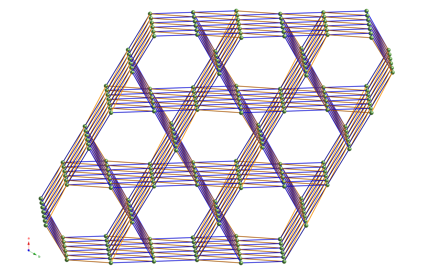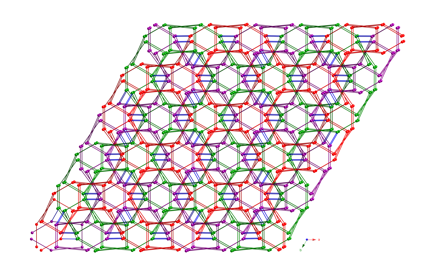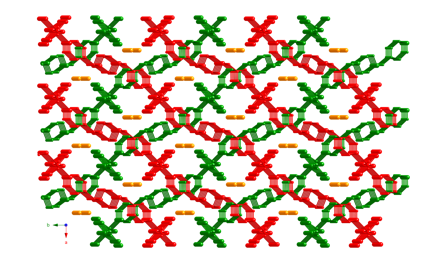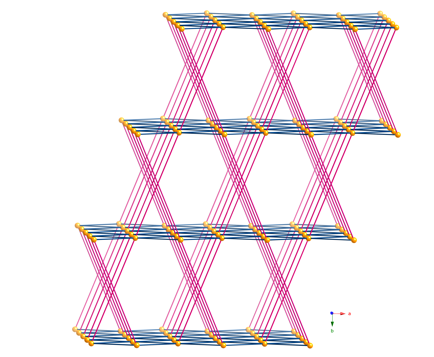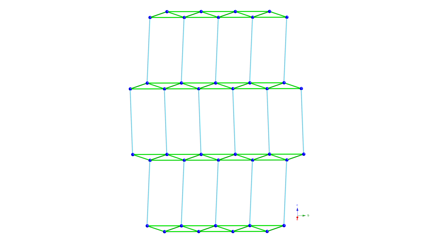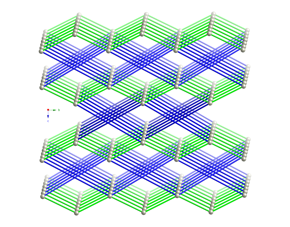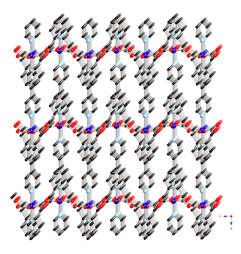Reports: B3
48311-B3 Synthesis, Structural Determination, and Physicochemical Property Studies of Novel Coordination Polymers Incorporating Kinked and Hydrogen-Bonding Capable Bifunctional Organodiimines
Over the past year the undergraduate-only LaDuca research group has explored the synthesis, structural characterization, and physical property investigation of divalent metal dicarboxylate coordination polymers containing hydrogen-bonding capable tethering dipyridyl ligands. During the timeframe June 2008 to August 2009, the group published 24 articles (13 papers/communications, 1 review, 10 structural reports), and has 4 articles in press. Stipends for six undergraduate researchers were covered by the grant; three of these students were women, including the SUMR scholar.
All of the undergraduates were deeply and independently involved in every aspect of the work: organic synthesis of the dipyridyl ligands, low- and high-temperature inorganic synthesis, single crystal X-ray crystallography, molecular graphics rendering, variable temperature magnetic susceptibility studies, emission spectroscopy, and thermogravimetric analysis. They also assisted in manuscript preparation. It is clearly evident that they developed laboratory and analysis techniques during their time in the research laboratory. Perhaps more importantly, they developed and honed these capabilities while preparing and analyzing new coordination polymer compounds, not while performing well-worn "canned" laboratory procedures.
The PI does not host any graduate students or postdoctoral fellows, because of his unique appointment within Lyman Briggs College at Michigan State University (an under-graduate-only residential college for the study of science and its impact on society). Thus the advancement of his research program depends critically on the hard work of these undergraduates.
Some highlights of work performed during the reporting period are listed below.
Copper phthalate coordination polymers incorporating the kinked and hydrogen-bonding capable imines 4,4¢-dipyridylketone (dpk) and 4,4¢-dipyridylamine (dpa) have been prepared and structurally characterized by single crystal X-ray diffraction. {[Cu(pht)(dpk)]¥0.33CH3OH}n (1, pht = phthalate) possesses helical subunits built from the fusion of [Cu(dpk)]n three-fold double helices and [Cu(pht)]n three-fold helices with opposite handedness. The resulting achiral [Cu(pht)(dpk)]n helices are conjoined by bridging pht carboxylate oxygen atoms to construct {Cu2O2} dimeric units, which serve as 8-connected nodes for a three-dimensional (3-D) coordination polymer lattice with an unprecedented 364125862 topology, evocative of a 3-D Kagome lattice. {[Cu2(pht)2(dpa)]¥H2O}n (2) manifests homochiral septuple left-handed [Cu2O2(dpa)]n helices formed by copper ions, phthalate oxygen atoms, and dpa ligands. The septuple helices are bracketed by pht anions to construct chiral one-dimensional (1-D) nanobarrels with solvent-free "star-shaped" channels. Compounds 1 and 2 display antiferromagnetic (J = –9.85(5) cm–1) and ferromagnetic (J = +1.36(3) cm–1) coupling across their {Cu2O2} dimeric units, respectively. (work performed by Maxwell Braverman and Joseph Nettleman, published in Inorganic Chemistry, 2009, 48, 4918–4926)
|
|
|
1
|
|
|
|
2
|
Use of divalent cadmium resulted in the luminescent chiral coordination polymer {[Cd(pht)(dpa)(H2O)]¥4H2O}n (3), which possesses an unprecedented 4-connected uninodal self-catenated three-dimensional 7482 network topology, constructed from the interlocking of [Cd(dpa)]n double helices with [Cd(pht)]n single helices. (work performed by Eric Shyu, published in Inorganic Chemistry, 2009, 48, 2723–2725, #1 accessed article online, April 2009)
|
|
|
|
|
|
|
3
|
Reaction of cadmium nitrate, maleic acid, and N,N'-bis(4-pyridylmethyl)piperazine (bpmp) in a methanol/water mixed solvent system at 25 °C resulted in an unexpected in situ isomerization and formation of {[Cd(fumarate)(bpmp)(H2O)2]¥2H2O}n (4), which exhibits a system of mutually interpenetrated [Cd(fumarate)(bpmp)(H2O)]n grid-like coordination polymer layers. A similar reaction using cadmium chloride and succinic acid produced {[Cd(succinate)(bpmp)(CH3OH)]¥2H2O}n (5), which manifests a chiral two-dimensional coordination polymer network with an unprecedented 658 topology. The differences in the conformations of the four-carbon dicarboxylate tethers (anti in 4, gauche in 5) and cadmium coordination environment (octahedral in 4, pentagonal bipyramidal in 5) play a significant role in structure direction during self-assembly. (work performed by David Martin, published in Dalton Transactions, 2009, 514–520)
|
|
|
4
|
|
|
|
5
|
The conformationally flexible dicarboxylate 1,2-phenylenediacetate (1,2-phda) proved beneficial for the construction of coordination polymers with rare topologies. {[Cu(1,2-phda)(dpa)]¥H2O}n (6) possesses a (4,6)-connected binodal supramolecular lattice with (4462)(446108) fsc topology. Use of a longer dipyridyl ligand afforded [Cu2(1,2-phda)2(dpp)]n (7, dpp = 1,3-di(4-pyridyl)propane), which manifests a rare self-penetrated rob lattice (48668 topology) built from the linkage of copper dicarboxylate layers through crossed dpp tethers. [Cu(1,2-phda)(H2O)(bpmp)0.5]n (8) forms a 5-connected Archimedean cem layer with 334453 topology. Strong antiferromagnetic coupling (J = –278(3) cm–1 with g = 2.28(1)) was observed within the {Cu2(OCO)4} "paddlewheels" in 7, while weak ferromagnetic superexchange (J = 3.5(9) cm–1 with g = 2.12(4)) along the {Cu(OCO)}n was evident in 8. (work performed by Laura K. Sposato, Crystal Growth & Design, submitted August 2009)
|
|
|
7
|
|
|
|
8
|
The coordination polymer {[Zn(dmg)(dpe)]¥H2O}n (9, dmg = 3,3-dimethylglutarate, dpe = 1,2-di(4-pyridyl)ethane) exhibits [Zn(dmg)]n chains that are connected by tethering dpe ligands into a unique uninodal 4-connected self-penetrated three-dimensional covalent network with 658 topology. While the Zn atoms serve as 4-connected tetrahedral nodes, the length mismatch between the gauche-gauche conformation dmg ligands and the anti-conformation dpe ligands prevents formation of a more commonly encountered 66 diamondoid topology. (work performed by Joseph Nettleman, CrystEngComm, manuscript in preparation, invited paper for "New Talent in the field of crystal engineering")
|
|
|
9
|
Different dipyridyl ligands have generated substantially different structures in divalent cobalt coordination polymers containing 1,2-phda ligands. Using dpa afforded [Co(1,2-phda)(dpa)(H2O)2]n (10), a simple (4,4) grid layered coordination polymer. On the other hand, the rigid-rod tether 4,4¢-bipyridine (bpy) resulted in formation of the three-dimensional coordination polymer [Co(1,2-phda)(bpy)]n (11). This material possesses 1-D cobalt carboxylate chains, linked into a 4,8-connected binodal lattice with a (324252)(344851264) topology. This network has been predicted mathematically, but has never been observed in coordination polymer chemistry. It is possible that the cobalt carboxylate chains in 11 can manifest S = 3/2 single chain magnetic behavior. Variable temperature and variable field magnetic susceptibility experiments are planned for the near future. (work performed by Karyn Blake, 2009 SUMR scholar. Upon completion of this work, submission to Inorganic Chemistry is planned.)
|
|
|
10
|
|
|
|
11
|
Work continues in our laboratory in this fertile research vein. While the project has borne significant scientific fruit, the intellectual development of the undergraduates involved in the research remains first and foremost.

